KZN Districts
- Sisonke
Overview
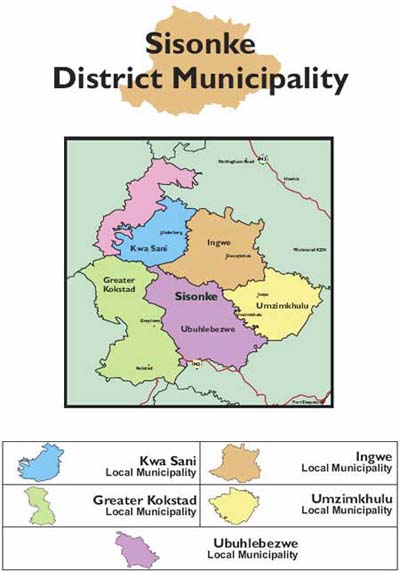
The district is the youngest of them all as it was only formed in 2000. The government is being seen as the key player in economic revitalisation of this district. Economically this district is the least contributor to the provincial GGP, standing at 2%. Statistically there are 298 374 people living in this district of which 40 733 are employed with a total labour force of 168 387.
Agricultural Sector
Agriculture is the most potential economic pillar in the district and provides job opportunities. Agricultural activities within the district are crop farming (i.e. potatoes and cabbages) and dairy farming. There are also commercial plantations which provide raw materials for paper. Other suitable agricultural activities that have potential for growth in the region are carrots, maize, oats, soyabeans, tomatoes, wheat, sorghum, sunflower and livestock but the problem lays in identifying specific locations for the enterprise.
Tourism Sector
The district has a great variety of natural tourism assets and accommodation establishments such as hotels,
bed & breakfasts and guest-houses. The district also has a missionary tourism, avi tourism (bird watching), cultural
tourism and eco-tourism, adventure tourism and the uKhahlamba, Drakensburg Park that can attract tourist into the
district.
Sisonke District Municipality
Sisonke municipality is situated in the south west of KwaZulu-Natal along the borders of the Eastern Cape.
The district has a largely rural population and it is an inland municipality that consist of five local
municipalities; Ubuhlenezwe, Greater Kokstad, KwaSani and UMzimkhulu. The towns of Kokstad and Matatiele are
recognized as the main economic hubs of the district. Sisonke is well endowed with natural resources and has
vast potential for the development of its main economic sectors that is agriculture and tourism.
No projects yet.
Development Corridors
Spatial Development Corridor
Nodes and Development Corridors for KZN for the next five years.
SC6 - Port Shepstone/St Faiths/Ixopo Corridor, focusing primarily on Developing a direct link between the
Southern Drakensberg and the Coastal areas to expand the basket of tourist destinations and spending options.
Nodes
Departmental Nodes - Sisonke
DC43: Agriculture and Land Reform
| Development of livestock, game, timber & vegetable farming potential on Trust land: address stock theft |
| Support land reform beneficiaries: this requires a farm worker strategy for the area, and consider opportunities for land reform beneficiaries in agri-tourism |
| Improve road linkages across Umzimkhulu |
| Develop Umzimkhulu as agricultural service centres |
| Develop Ixopo, Underberg, Kokstad as agricultural service and agri-processing centres |
DC43: Tourism
| Drakensberg: ensure adequate control of land use, improve direct road link between Central & Southern Berg, link to Midlands Meander through Impendle & Nottingham Road |
| Ingwe / Paton tourism development |
DC43: Services
| Formalise and plan Umzimkulu to position for investment |
| Provide adequate affordable housing and related services in nodes |
Agrarian Revolution Target Areas (2006/7)
Finally, the Agrarian Revolution Strategy has clearly identified targeted Districts for 2006/7 which should each receive approximately R35m of Siyavuna funding . Each district will have specific targeted commodity focus areas that respond to the Provincial Agricultural Framework, areas of identified Hunger, and the priority areas identified by the Provincial Government and the Premier for 2006/7 specifically.
Existing Investors
Sisonke Municipality
Sisonke municipality is situated in the south west of KwaZulu-Natal along the borders of the Eastern Cape. The district has a largely rural population and it is an inland municipality that consist of five local municipalities; Ubuhlenezwe, Greater Kokstad, KwaSani and UMzimkhulu. The towns of Kokstad and Matatiele are recognized as the main economic hubs of the district. Sisonke is well endowed with natural resources and has vast potential for the development of its main economic sectors that is agriculture and tourism.
Amajuba District: Socio-Economic Profile
- Demographic Profile
- The population of KwaZulu-Natal has been growing and maturing over the years, and has thus posed both challenges as well as opportunities to the province. According to Statistics South Africa, the province’s population was estimated at 10,1 million people in 2006. The largest proportion of these people lived in eThekwini Metro (32.4%), followed by uThungulu (10.2%), and uMgungundlovu (10.0%). Sisonke district had an estimated average population of 382,174, accounting for 5.9 percent of the provincial population between 2002 and 2006 (Figure 10.1).
- The majority of the population in Sisonke and across all DMs was female during this period (53%) (Figure 10.3).
- Economic Outlook
- Between 2002 and 2006, the GDPR for KwaZulu-Natal was estimated at an annual average of R177,8bn. There was a significant growth of 18.8 percent from R163,9bn in 2002 to R194,7bn in 2006. EThekwini, uThungulu, and uMgungundlovu were the highest contributors to the KwaZulu-Natal’s GDP-R at 64.6 percent, 9.5 percent, and 8.5 percent respectively. Sisonke contributed the least to the provincial economy 1.1 percent, outpacing only uMzinyathi that put in only 0.8 percent.
- Figure 10.5 shows Sisonke’s GDP-M by economic sector between 2002 and 2006. During this period, the economy of the district grew by an annual average of 2.3 percent. Agriculture, Community Services, and Trade were the main drivers of the district’s economy with average contributions of 33.5 percent, 33.3 percent, and 12.8 percent, respectively. Finance, Construction, and Trade were the fastest growing sectors, yielding average growth rates of 8.1 percent, 4.0 percent, and 3.8 percent respectively. Despite the overall stagnancy over the years, Sisonke’s Agriculture contracted sharply between 2005 and 2006 moving from 5.2 percent in 2005 to -7.8 percent in 2006, while Finance grew precipitously at 21.0 percent between 2005 and 2006 from 1.5 percent to in 2005.
- International Trade
- Figure 10.6 shows the proportions of exports, imports and trade balance (to the districts’ GDP-M) across all DMs. Sisonke’s international trade was very minimal; on average, the district’s imports were 0.1 percent and its exports 0.3 percent of the GDP-M from 2002 to 2006, resulting in a trade surplus of 0.1 percent of the district’s GDP-M. The district ranked along the smallest role-players in this activitiy, such as uMkhanyakude and Zululand, and was in fact the smallest of them all.
- The Labour Market
- Between 2002 and 2006, when the provincial labour force1 approximated 6,0 million people per annum (approximately 60.0 percent of total provincial population), the economically active population (EAP)2 was approximately 3,1 million. More than 1,4 million of the province’s EAP was found in eThekwini, followed by UMgungundlovu (360,000) and uThungulu (221,000). Sisonke held the last-but-two position with about 92,000 people falling in this category (Figure 10.7).
- 1 Labour force is population aged 15-64 years.
2 The category EAP is made up of people who are either employed or unemployed. The employed consists of employers and employees, while unemployment are those not having a job but are actively seeking one (official definition), or they do not have a job, are actively seeking one or have given up searching yet still available for work at anytime (expanded definition).
As a proportion of the district labour force3, the district’s EAP was about 36.0 percent. At this rate, the district was again the third highly economically inactive after uMkhanyakude (30.0%) and uMzinyathi (35.0%). - Unemployment
- During this period, there were about 50,000 unemployed people in the district. This was the lowest level of unemployment in the province.
- The district’s unemployment rate45 was relatively high at about 48.0 percent; towering those of eThekwini,
Amajuba, uThungulu and iLembe, and 2.2 percentage points above provincial level.
As with the other districts, Amajuba’s unemployment rate was skewed towards the Blacks (48.4%). The respective rates for Coloureds, Indians and Whites were 34.6, 19.6 and 10.7 percent. However, the Blacks’ unemployment rate was generally lower than the patterns observed in a majority of the previously discussed districts.
3 EAP/LF = Labour participation rate or ratio.
4 Unemployment rate is the ratio of the unemployed to the EAP
5 Global Insight makes use of the expanded definition of unemployment, this includes those unemployed but not actively seeking a job - Employment
- During the period under review, KwaZulu-Natal employment totaled an annual average of 2,1 million workers. Sisonke’s employment was still the lowest of all districts in the province (Figure 10.10).
- The district’s formal employment was among the relatively higher levels at 70.4 percent of total employment (Figure 10.11). Agriculture, Community Services and Household Services, sectors played a significant role in the district’s formal employment, together accounting for about 84.0 percent of the district’s formal employment (Figure 10.12).
- As with the other districts, employment in Agriculture, the co-major employer with Community Services, has seen declines recently. A larger part of this sector’s employment was recorded in Agriculture and Hunting industry than in Forestry and Logging; Fishing was an unpopular industry in this district.
- KwaZulu-Natal’s informal sector employment, recorded mainly in Trade, Construction, Community Services, Manufacturing, Transport and Finance6 sectors, was generally skewed towards the Trade sector. This was true in all but four districts, each having at least half the employment in this sector involved in trade of some kind; Sisonke had a similar experience. As with Ugu, the district also had a uniquely high employment in Constriction at 17.0 percent this was complemented by Community Service, also at nearly 17.0 percent (Figure 10.14).
- 6 These are the sectors recorded by Global Insight; they are easier to monitor and collect data thereon than the remaining others.
- Figure 10.15 shows the distribution of Sisonke’s formal employment in the Trade sector, the leading contributor to informal employment. The district’s formal employment in trade was skewed towards three of the four main industries, with ‘Hotels & Restaurants’ leading at 32.8 percent. The informal employment sector could also have followed a similar structure. Formal employment in ‘Community Services’, on the other hand, was dominated by ‘Public Administration & Defense Activities’ and ‘Health & Social Work’, with ‘Education’ recording a virtually insignificant contribution.
- In 2006, Sisonke’s share of the KwaZulu-Natal soil was 11.9 percent, the fourth largest district after Zululand, uMkhanyakude and uThukela (Figure 10.16).
- However, similar to the majority other districts with massive expanse, the district had a large portion of its land unavailable for agricultural purposes (62.3% being unimproved grassland), with temporary or permanent cultivation carried out on only 13.2 percent (for both) (Figure 10.17). This should be an eye-sore as, similar to the rest of the districts, formal employment in agriculture in this district is shrinking, in the presence of so low a share used for cultivation.
- Between 2002 and 2006, there was a consistent decline in reported incidences of crime in the province
(2.4% annual average). UMkhanyakude, and uThungulu to a less extent, was the only district resistant to
declining crime rates. However, 2003 forward saw a comprehensive decline, though with differing magnitudes;
the provincial collapse rate in crime incidents was 5.1 percent. Sisonke was one of the districts that enjoyed
the highest decline of at least 8.0 percent (Figure 10.18).
During the same period 2002 to 2006, the most common crimes in this district were theft, burglary and assault. Sisonke also had a unique experience of stock theft. This district was one of the safest areas with rates as low as 430 incidences per 100,000 people (Figure 10.18). This is worth applause as the already low levels have also recorded declines. - Figure 10.20 shows urbanisation rates, poverty rate, Gini coefficient and Human Development Index (HDI) for Sisonke. It transpires from this graph that the proportion of people living in poverty in the district has been fluctuating. The rate of urbanisation has, on the contrary, increased slowly from 11.8 percent in 2002 to 12.9 percent in 2006, and the income gap has widened (Gini coefficient rose from 0.58 to 0.62).
- However, the overall human development in the districts has improved, with the index increasing from 0.42 to 0.45 – although still low by international standards.
- Figure 10.21 confirms that wide income gap, with nearly 94.0 percent of the district’s households earning R72,000 per annum. This was one of widest income gaps in the province.
 10.2 shows the distribution of the population across DMs by age group. The largest proportion of
the population in Sisonke was the age group 15-64 years (57.4%), followed by the age group 0-14 years (39.0%).
The elderly population made the smallest portion of the total population.
10.2 shows the distribution of the population across DMs by age group. The largest proportion of
the population in Sisonke was the age group 15-64 years (57.4%), followed by the age group 0-14 years (39.0%).
The elderly population made the smallest portion of the total population.More potential work seekers translate into higher unemployment levels, particularly if individuals are not appropriately skilled. Hence, the higher number of both young individuals and people in the labour force overall will require more spending in education (primary and secondary) and skills development.
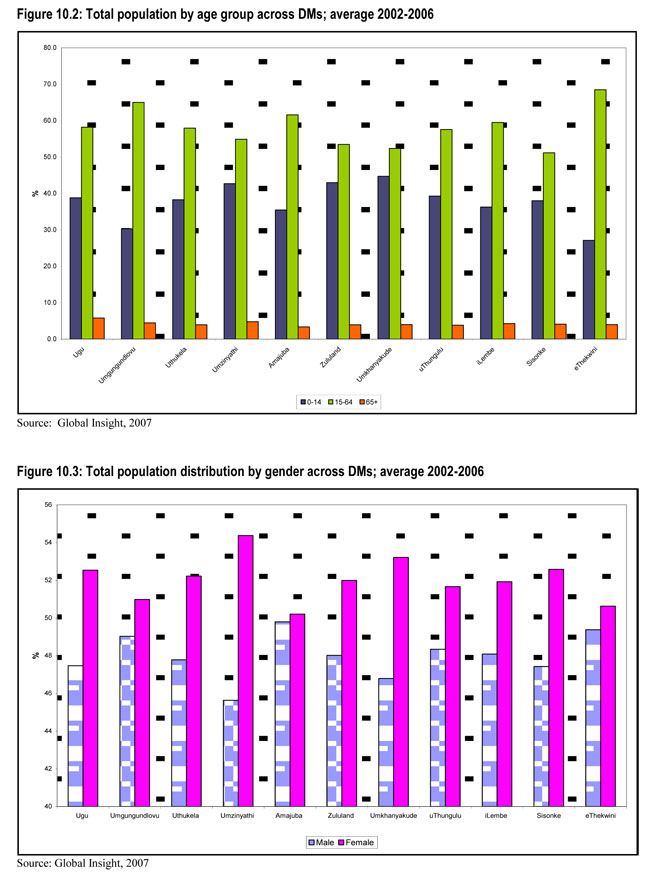
Gross domestic product per municipality (GDP-M)


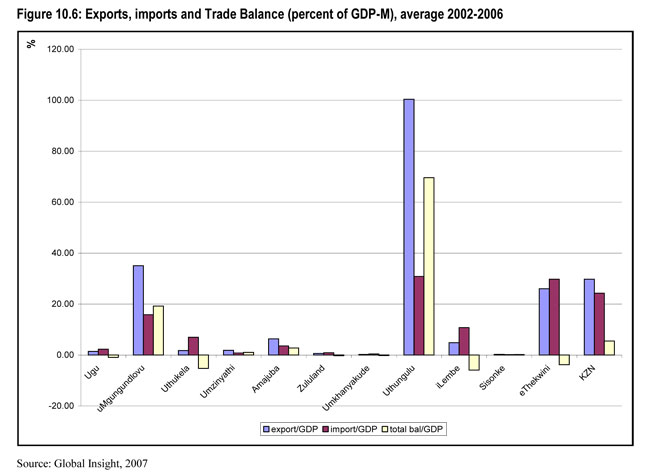
The labour force and the economically active population
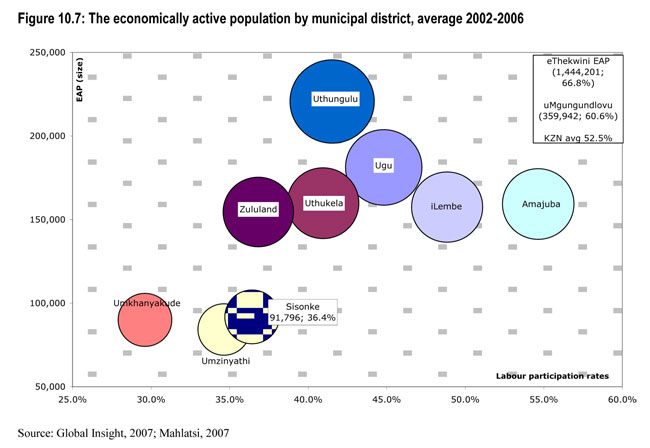
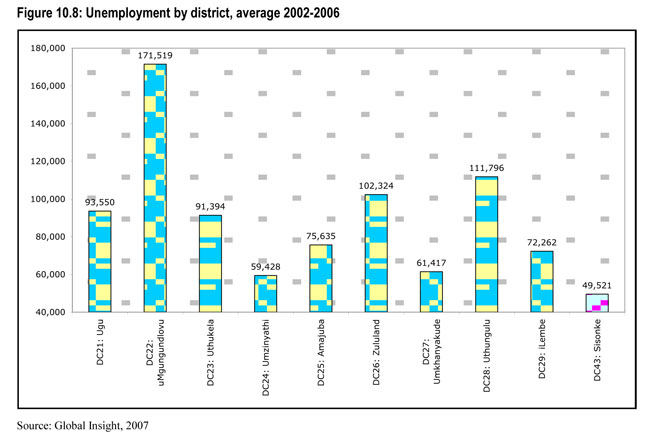

Total employment
Formal employment
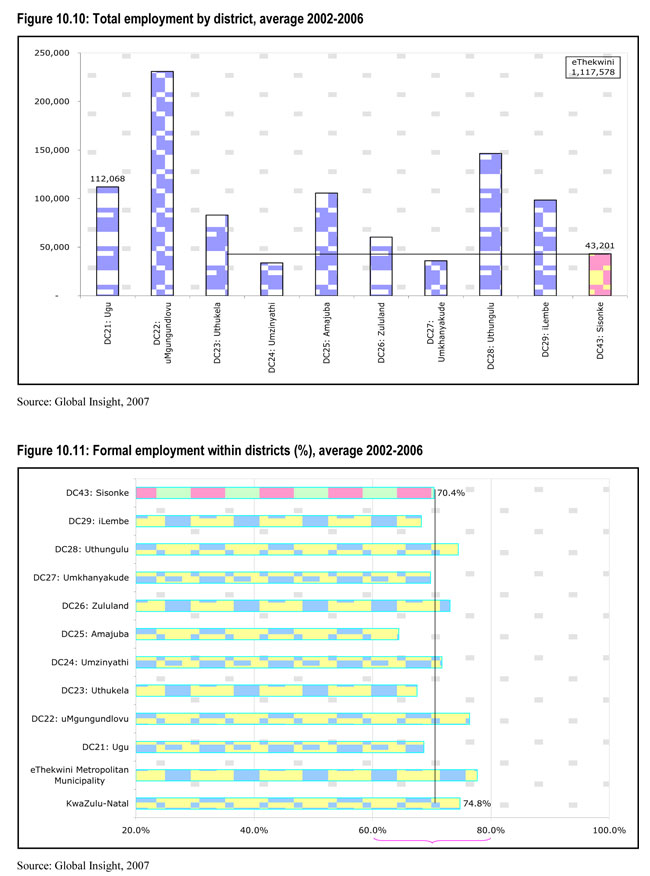
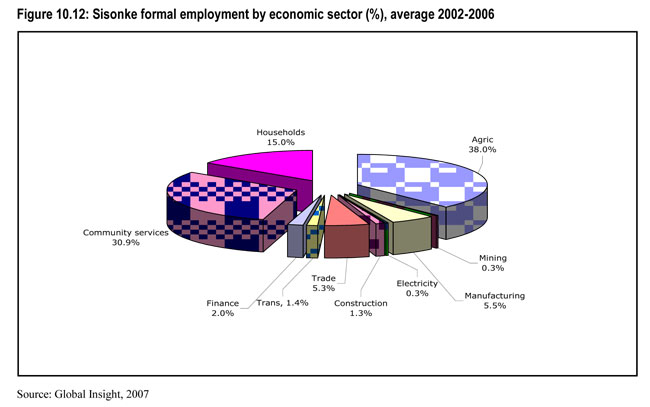

Informal employment
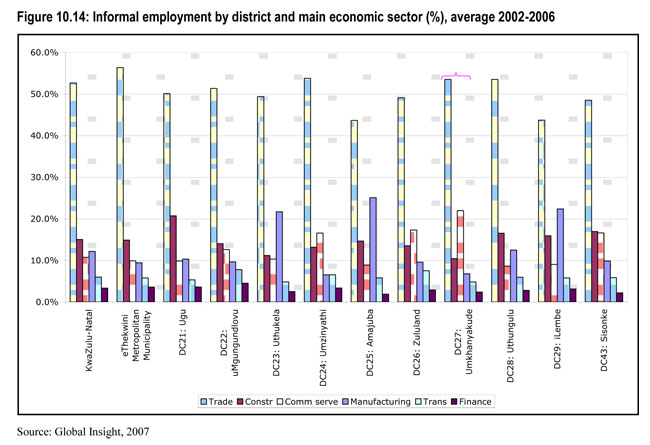
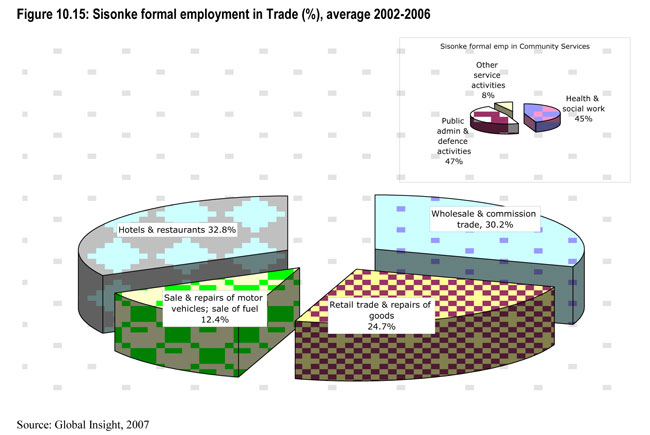
Land Cover and Use
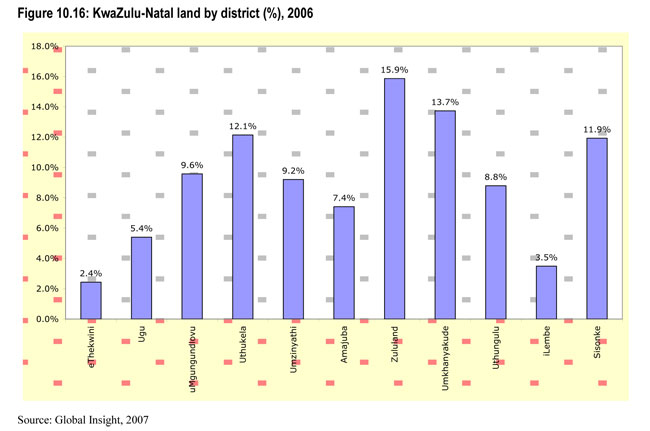
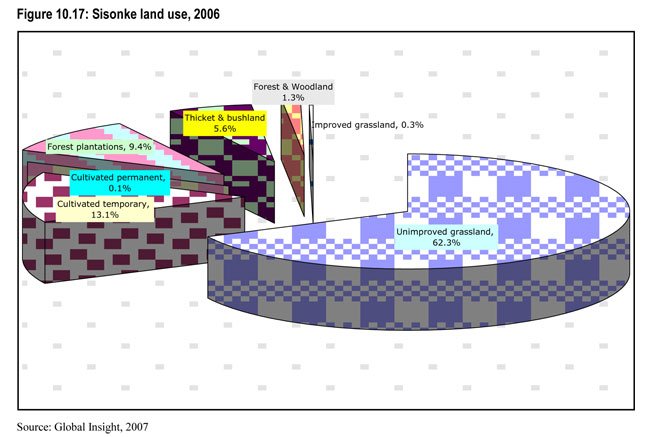
Crime

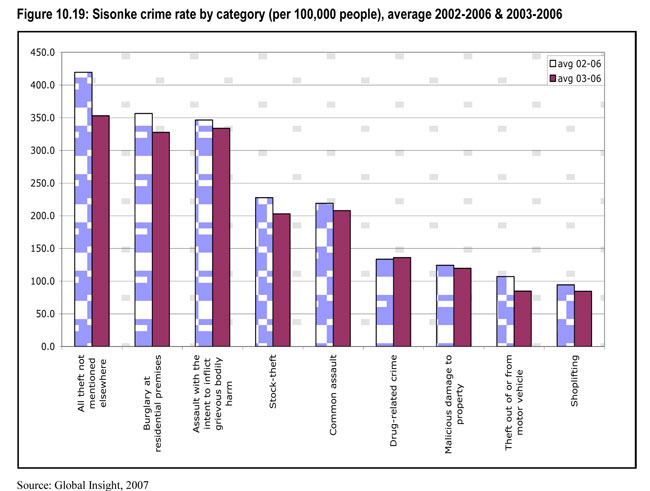
Social Development
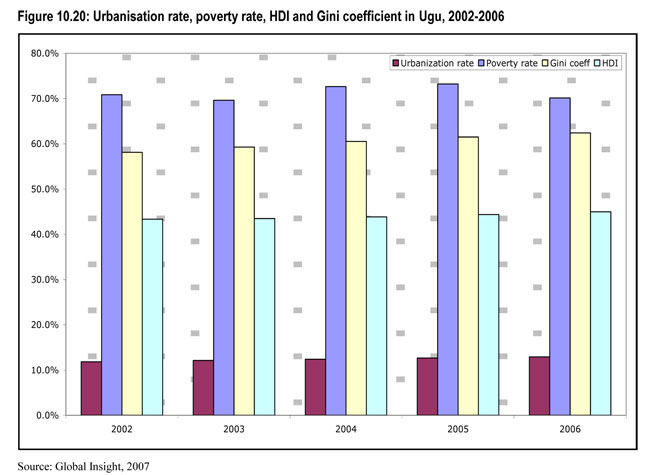
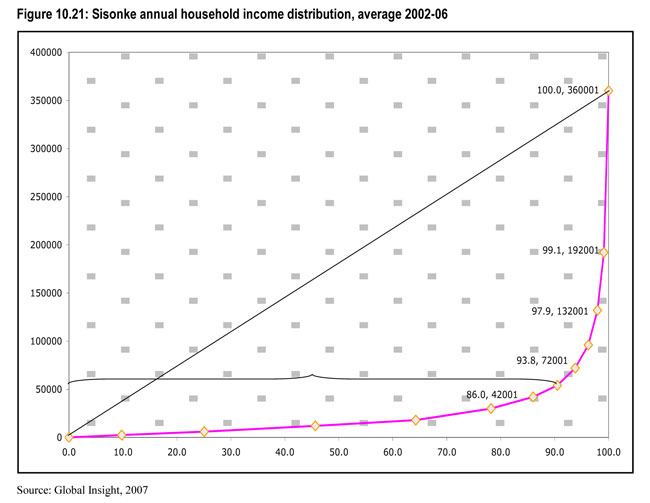
Contact Details
- MM: Mr N M Mabaso
P/Bag X501 Ixopo 3276
40 A Main Street Ixopo 3276
Tel: 039 834 8700
Fax: 039 834 1701
E-mail: mabasom@sisonkedm.gov.za or mbhelelel@sisonkedm.gov.za
Website: www.sisonke.gov.za
| Local Municipality | Telephone | Facsimile | |
|---|---|---|---|
| Ingwe | 039 833 1038 | 039 833 1179 | brownm@ingwe.gov.za |
| KwaSani | 033 702 1060 | 033 702 1148 | mm@kwasani.co.za mmpa@kwasani.co.za |
| Greater Kokstad | 039 797 6600 | 039 727 3676 | municipality@kokstad.org.za |
| Ubuhlebezwe | 039 834 7700 | 039 834 1168 | mm@ubuhlebezwe.org.za |
| UMzimkhulu | 039 259 0216 / 5309 | 039 259 0427 | zsikhosana@umzimkhululm.gov.za jkhonza@umzimkhululm.gov.za |
Other Projects
The government projects are the responsibility of each respective government department, therefore TIKZN is not responsible for the updating of this information. For further assistance, kindly contact the department responsible directly. Follow this link for available projects:
http://www.kwazulunatal.gov.za
GALLERIES
Despite the fact that KwaZulu-Natal covers such a small portion of South Africa's land area, a significant percentage of the country's small-scale farmers are based here. Agriculture in KwaZulu-Natal is extremely diverse and is reflected in the patterns of its topography. Most of the world's agricultural activities can be practised here. Due to the good reliable rainfall and fertile soils, the region's agricultural sector has become very productive, and is known for its specialist capability in several types of farming. The Province has a total of 6.5 million hectares of land for farming purposes of which 82% is suitable for extensive livestock production and 18% is arable land.

Types of Agriculture
The agricultural sector is focused mainly on the following:
Crops: Sugar, Maize
Horticulture: Sub-tropical fruits especially pineapples and bananas, Cashew nuts, Potatoes, Vegetables
Animal Husbandry: Beef, Sheep (mutton and wool), Pigs, Poultry
Forestry: SA Pine, Saligna, Black Wattle, eucalyptus, poplar,
There is tremendous potential for agricultural expansion in KwaZulu-Natal. It has been conservatively
estimated that if the agricultural natural resources were optimally managed, the present production yield
could be increased dramatically, thus unlocking the full agricultural production potential of KwaZulu-Natal.

Social Programmes
The social programs and the government/private sector joint projects that have been facilitated and implemented by the sugar industry bear testimony to the industry's conscious commitment to the socio-economic and welfare upliftment of its employees. The key challenge for the sugar cane industry remains the maintenance of competitiveness in relation to other world-class producers and industries.
Contact Details
- Mr Francois Beatrix
- Manager
- Export Promotion
- 1 Arundel Close, Durban, KZN, 4001
- +27 31 368 9600
- Contact Mr Francois Beatrix
